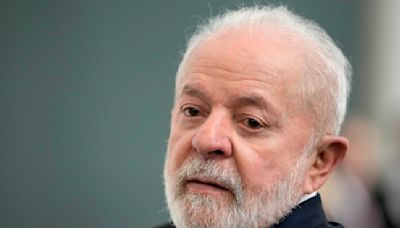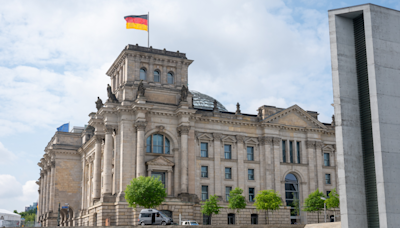Search results
- Germany, officially the Federal Republic of Germany, is a country in the western region of Central Europe. It is the second-most populous country in Europe after Russia and the most populous member state of the European Union.
www.wikiwand.com › en › Germany
People also ask
What is Germany's political system based on?
What type of government does Germany have?
When did Germany become a state?
Where is Germany located in Europe?
Germany, officially the Federal Republic of Germany, is a country in the western region of Central Europe. It is the second-most populous country in Europe after Russia [g] and the most populous member state of the European Union .
3 days ago · Officially: Federal Republic of Germany. German: Deutschland or Bundesrepublik Deutschland. Head Of Government: Chancellor: Olaf Scholz. Capital: Berlin 3. Population: (2024 est.) 86,303,000. Currency Exchange Rate: 1 USD equals 0.932 euro. Head Of State: President: Frank-Walter Steinmeier. Recent News.
Germany is a federal, parliamentary, representative democratic republic. Its political system is based on the constitutional law, known as the Grundgesetz (Basic Law) Germany's constitutional law was approved on 8 May 1949 in the city of Bonn, at that time the provisional German capital.
- Overview
- Constitutional framework
- Regional and local government
The structure and authority of Germany’s government are derived from the country’s constitution, the Grundgesetz (Basic Law), which went into force on May 23, 1949, after formal consent to the establishment of the Federal Republic (then known as West Germany) had been given by the military governments of the Western occupying powers (France, the United Kingdom, and the United States) and upon the assent of the parliaments of the Länder (states) to form the Bund (federation). West Germany then comprised 11 states and West Berlin, which was given the special status of a state without voting rights. As a provisional solution until an anticipated reunification with the eastern sector, the capital was located in the small university town of Bonn. On October 7, 1949, the Soviet zone of occupation was transformed into a separate, nominally sovereign country (if under Soviet hegemony), known formally as the German Democratic Republic (and popularly as East Germany). The five federal states within the Soviet zone were abolished and reorganized into 15 administrative districts (Bezirke), of which the Soviet sector of Berlin became the capital.
Full sovereignty was achieved only gradually in West Germany; many powers and prerogatives, including those of direct intervention, were retained by the Western powers and devolved to the West German government only as it was able to become economically and politically stable. West Germany finally achieved full sovereignty on May 5, 1955.
East Germany regarded its separation from the rest of Germany as complete, but West Germany considered its eastern neighbour as an illegally constituted state until the 1970s, when the doctrine of “two German states in one German nation” was developed. Gradual rapprochements between the two governments helped regularize the anomalous situation, especially concerning travel, transportation, and the status of West Berlin as an exclave of the Federal Republic. The dissolution of the communist bloc in the late 1980s opened the way to German unification.
As a condition for unification and its integration into the Federal Republic, East Germany was required to reconstitute the five historical states of Brandenburg, Mecklenburg–West Pomerania, Saxony, Saxony-Anhalt, and Thuringia. As states of the united Germany, they adopted administrative, judicial, educational, and social structures parallel and analogous to those in the states of former West Germany. East and West Berlin were reunited and now form a single state.
With the country’s unification on October 3, 1990, all vestiges of the Federal Republic’s qualified status as a sovereign state were voided. For example, Berlin was no longer technically occupied territory, with ultimate authority vested in the military governors.
Germany’s constitution established a parliamentary system of government that incorporated many features of the British system; however, since the Basic Law created a federal system, unlike the United Kingdom’s unitary one, many political structures were drawn from the models of the United States and other federal governments. In reaction to the centralization of power during the Nazi era, the Basic Law granted the states considerable autonomy. In addition to federalism, the Basic Law has two other features similar to the Constitution of the United States: (1) its formal declaration of the principles of human rights and of bases for the government of the people and (2) the strongly independent position of the courts, especially in the right of the Federal Constitutional Court to void a law by declaring it unconstitutional.
The structure and authority of Germany’s government are derived from the country’s constitution, the Grundgesetz (Basic Law), which went into force on May 23, 1949, after formal consent to the establishment of the Federal Republic (then known as West Germany) had been given by the military governments of the Western occupying powers (France, the United Kingdom, and the United States) and upon the assent of the parliaments of the Länder (states) to form the Bund (federation). West Germany then comprised 11 states and West Berlin, which was given the special status of a state without voting rights. As a provisional solution until an anticipated reunification with the eastern sector, the capital was located in the small university town of Bonn. On October 7, 1949, the Soviet zone of occupation was transformed into a separate, nominally sovereign country (if under Soviet hegemony), known formally as the German Democratic Republic (and popularly as East Germany). The five federal states within the Soviet zone were abolished and reorganized into 15 administrative districts (Bezirke), of which the Soviet sector of Berlin became the capital.
Full sovereignty was achieved only gradually in West Germany; many powers and prerogatives, including those of direct intervention, were retained by the Western powers and devolved to the West German government only as it was able to become economically and politically stable. West Germany finally achieved full sovereignty on May 5, 1955.
East Germany regarded its separation from the rest of Germany as complete, but West Germany considered its eastern neighbour as an illegally constituted state until the 1970s, when the doctrine of “two German states in one German nation” was developed. Gradual rapprochements between the two governments helped regularize the anomalous situation, especially concerning travel, transportation, and the status of West Berlin as an exclave of the Federal Republic. The dissolution of the communist bloc in the late 1980s opened the way to German unification.
As a condition for unification and its integration into the Federal Republic, East Germany was required to reconstitute the five historical states of Brandenburg, Mecklenburg–West Pomerania, Saxony, Saxony-Anhalt, and Thuringia. As states of the united Germany, they adopted administrative, judicial, educational, and social structures parallel and analogous to those in the states of former West Germany. East and West Berlin were reunited and now form a single state.
With the country’s unification on October 3, 1990, all vestiges of the Federal Republic’s qualified status as a sovereign state were voided. For example, Berlin was no longer technically occupied territory, with ultimate authority vested in the military governors.
Germany’s constitution established a parliamentary system of government that incorporated many features of the British system; however, since the Basic Law created a federal system, unlike the United Kingdom’s unitary one, many political structures were drawn from the models of the United States and other federal governments. In reaction to the centralization of power during the Nazi era, the Basic Law granted the states considerable autonomy. In addition to federalism, the Basic Law has two other features similar to the Constitution of the United States: (1) its formal declaration of the principles of human rights and of bases for the government of the people and (2) the strongly independent position of the courts, especially in the right of the Federal Constitutional Court to void a law by declaring it unconstitutional.
Certain functions (e.g., education and law enforcement) are expressly the responsibility of the states, yet there is an attempt to maintain a degree of uniformity among the 16 states through joint consultative bodies. The state governments are generally parallel in structure to that of the Bund but need not be. In 13 states the head of government has a cabinet and ministers; each of these states also has its own parliamentary body. In the city-states of Hamburg, Bremen, and Berlin, the mayor serves simultaneously as the head of the city government and the state government. In the city-states the municipal senates serve also as provincial parliaments, and the municipal offices assume the nature of provincial ministries.
The administrative subdivisions of the states (exclusive of the city-states and the Saarland) are the Regierungsbezirke (administrative districts). Below these are the divisions known as Kreise (counties). Larger communities enjoy the status of what in the United Kingdom was formerly the county borough. The counties themselves are further subdivided into the Gemeinden (roughly “communities” or “parishes”), which through long German tradition have achieved considerable autonomy and responsibility in the administration of schools, hospitals, housing and construction, social welfare, public services and utilities, and cultural amenities. Voters may pass laws on certain issues via referenda at the municipal and state levels.
May 22, 2024 · Environment - current issues. emissions from coal-burning utilities and industries contribute to air pollution; acid rain, resulting from sulfur dioxide emissions, is damaging forests; pollution in the Baltic Sea from raw sewage and industrial effluents from rivers in eastern Germany; hazardous waste disposal; government established a mechanism for ending the use of nuclear power by 2022 ...
Germany, officially the Federal Republic of Germany, is a country in the western region of Central Europe. It is the second-most populous country in Europe after Russia and the most populous member state of the European Union. Germany lies between the Baltic and North Sea to the north and the Alps to the south.
Sep 4, 2023 · Capital: Berlin. Area: 357,022 sq km. Population: 83.6 million. Language: German. Life expectancy: 78 years (men) 83 years (women) LEADERS. Chancellor: Olaf Scholz. Getty Images. The 63-year-old...







